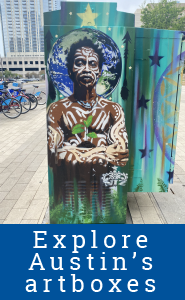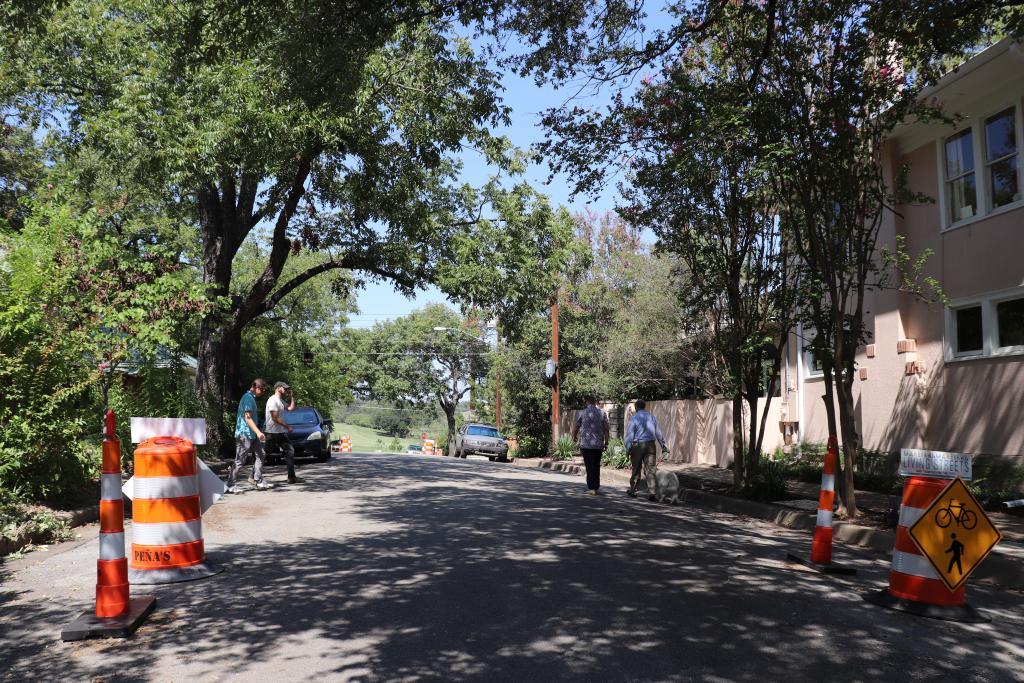
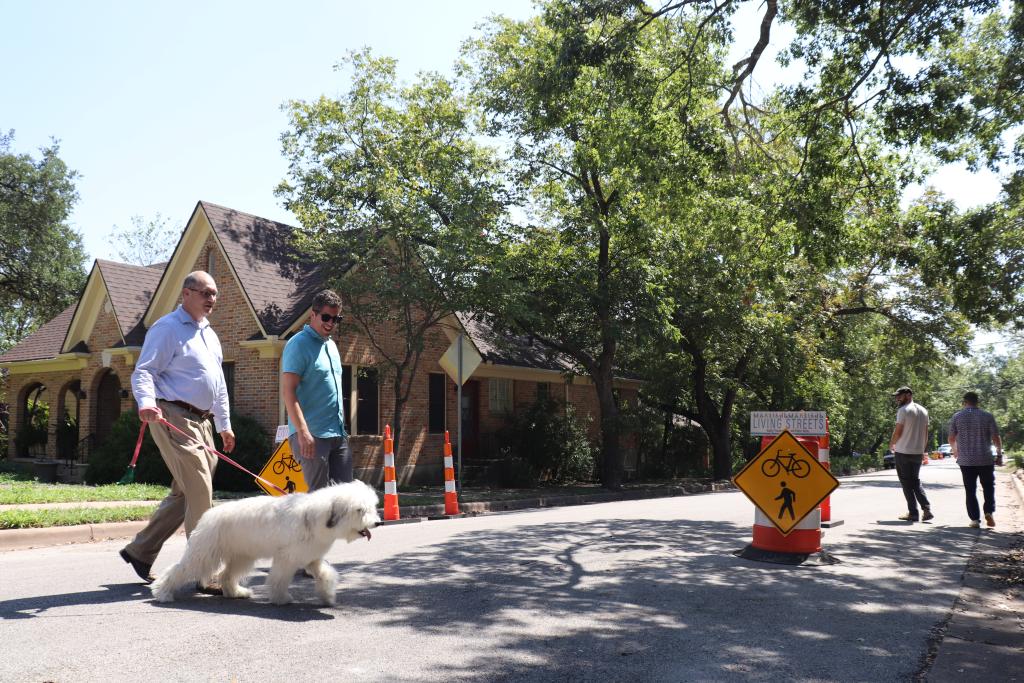
- Living Streets Improvements
-
As a response to resident feedback Living Streets staff are in the process of making improvements to the Neighborhood Block Party and Healthy Streets Programs! After hearing community comments:
- The Block Party application will be easier and simpler to complete.
- The Healthy Streets Program is rolling out changes to its equipment in two phases.
- Phase 1 reduces the number of pieces of equipment and replaces the ‘Local Traffic Only’ signs with yellow bicycle-pedestrian warning signs.
- Phase 2 aims to improve the equipment to align with community feedback and enhance Healthy Street safety, aesthetics, and maintenance efficiency.
- Program Values
-
Living Streets envisions local streets as places where communities can walk, bike, gather, and connect. The program offers residents a set of options for activating neighborhood streets to create opportunities for safe community-building throughout the city.
- Equity: Living Streets activations are located in a socially vulnerable area based on the City’s Equity Analysis Zones.
- Neighborhood support: a high percentage of residents living along proposed Living Street activations support them.
- Need for recreational space: Living Streets activations are located in an areas with few parks.
- Neighborhood connections: Living Streets activations help connect to destinations such as parks, libraries, and cultural locations.
- Need for multimodal infrastructure: Living Streets activations help create safer walking conditions in areas with incomplete sidewalks.
Living Streets encompasses three types of resident-led street activations:
![]()
Neighborhood Block Parties
Neighborhood Block Parties are a fun, easy way to build community and get to know your neighbors. Block Parties are one-time closures of a single block to allow residents to hold small, locally-focused gatherings.
- More about Neighborhood Block Parties
-
Neighborhood Block Parties give neighbors a chance to connect, enjoy the public realm of the street, share information, and celebrate events together. The program allows residents to temporarily close a street for up to 24 hours and hold parties to connect with their neighbors.
The City of Austin encourages residents and neighborhood groups to organize block parties on their nearby residential streets through the program application process. An adult monitor must be stationed at both ends of the street at the closures at all times.
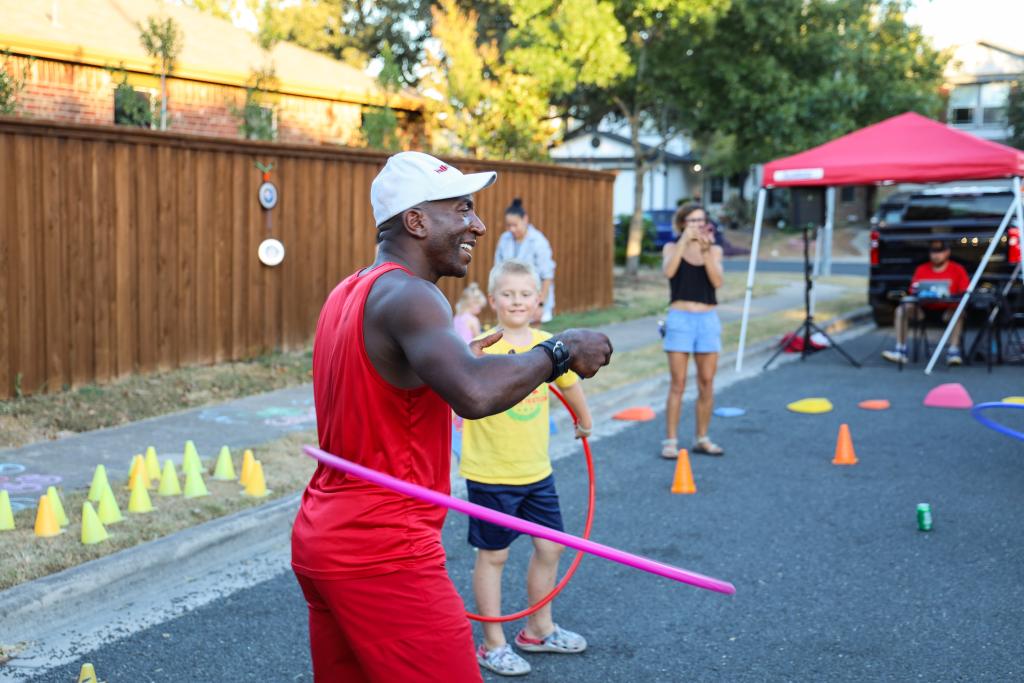
What is a Neighborhood Block Party?
A block party:
- Is open to all residents
- Is a one-time closure of a residential street
- Does not include vendors (food trucks are allowed on private property)
- Does not include alcohol sales
To be eligible for the Neighborhood Block Party Program, a street must:
- The deadline for submission is 15 calendar days prior to the party date
- Has a speed limit of 25 mph or less
- Be a full, single block that:
- Does not include intersections
- Can be closed at each cross street (is not a midblock closure)
- Be a residential street of primarily single-family/duplex homes. Streets with multifamily buildings, schools, places of worship and commercial businesses have special rules and will be considered on a case-by-case basis.
- Receive support from at least 60% of the households along the street. 100% of the block must be notified.
To be eligible for Block Party Program, the street must NOT:
- Affect a traffic signal
- Affect a transit route
- Have paid parking on either side
- Be located on an arterial or collector street (high-capacity urban road)
![]()
Healthy Streets
Healthy Streets provide space for people to walk, bike, roll, exercise and build community within the public right-of-way by discouraging motor vehicle traffic along several local streets.
- More about Healthy Streets
-
Like other cities around the globe, Austin implemented an initial version of its Healthy Streets Program in response to the COVID-19 pandemic in 2020 as a way to provide more space for people to walk, bike, and exercise outdoors in a socially-distanced environment.
Today, Austin continues to see its local streets as places for more than just driving, and the Healthy Streets Program continues to provide space for other modes of transportation at all times of day.
Through the City’s, resident-led version of the Healthy Streets Program, Austinites across the city will have the opportunity to apply for a Healthy Street spanning 3-4 blocks on a local street in their neighborhood.
After selecting resident-led applications for implementation, City staff will install and maintain semi-permanent equipment that discourages motor vehicle traffic and provides more space for walking, biking, and rolling.
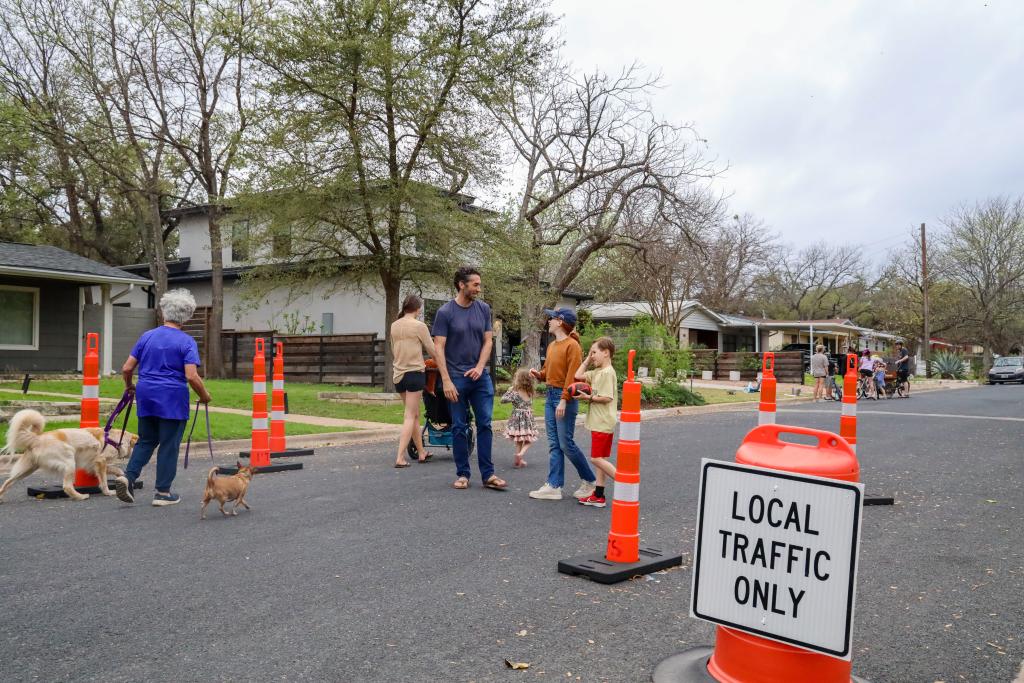
Eligible Streets
To be eligible for the Healthy Streets Program, a street must:
- Be a local road (ASMP Class 1 road or lower)
- Be approximately 25-40 feet wide
- Be a residential street (90% or more residential). Streets with multifamily buildings will be considered on a case-by-case basis. If there is a school or place of worship on the block, they must approve the equipment.
- Receive support from at least 60% of the households along the corridor
To be eligible for the Healthy Streets Program, streets must NOT:
- Connect directly to a major arterial road
- Affect a traffic signal
- Affect a transit route
![]()
Play Streets
Play Streets provide space for children and adults alike to gather and play in a local street by allowing residents to partially close a single block to motor vehicle traffic for a few hours per day several days per week.
- More about Play Streets
-
Play Streets provide space for children and adults alike to gather and play in a local street by allowing residents to close a single block to non-local motor vehicle traffic for a few hours per day several days per week.
Play Streets programs date back to the 1930s when London residents envisioned local streets as a place for play and community interaction. Since the pandemic, a growing number of cities have implemented programs that allow recurring street closures to support this goal.
Austin’s Play Streets Program aims to transform our local streets into places where families can meet and kids can play safely with minimal car traffic.
The Play Streets Program allows residents to close a single block to most motor vehicle traffic up to 3 days a week for up to 12 hours a week. After applying and being selected for the program, residents will receive equipment like barricades and signs from the City.
Designated Living Streets Ambassadors living on the block are responsible for implementing the Play Street and setting up approved street closure treatments repeatedly at the agreed-upon times. An adult monitor must be stationed at the closures at all times. This monitor can be an ambassador or another adult. We recommend applicants start with selecting a total of 6 hours per week for a Play Street. If the applicant wants additional hours after the activation has been installed, the times can be adjusted.
Play Streets will remain open to traffic from residents, deliveries, and emergency response.
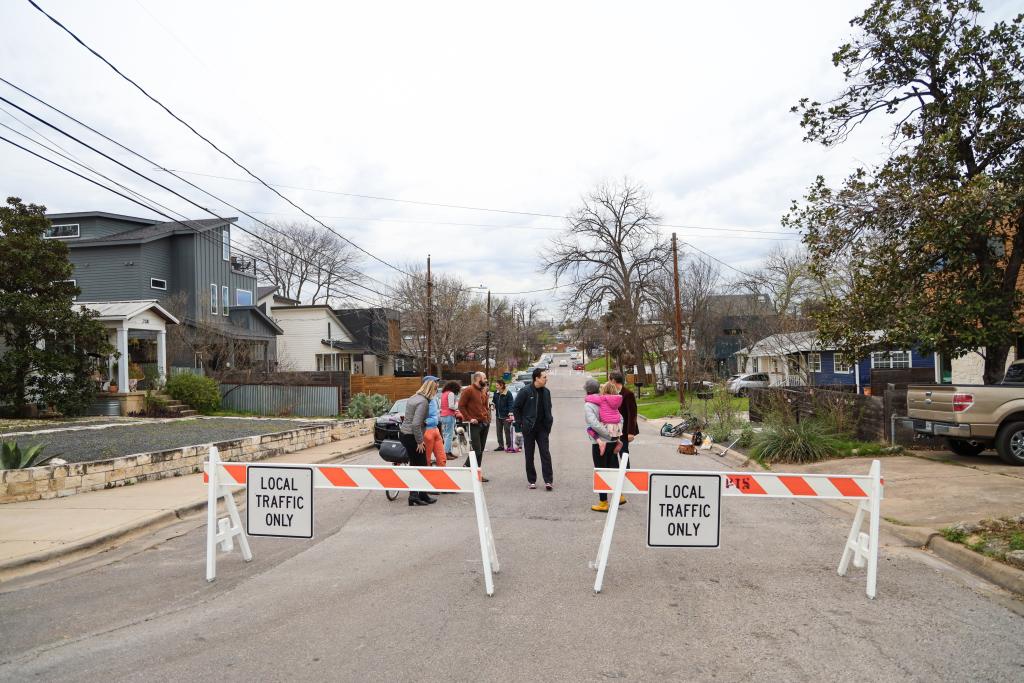
Eligible Streets
To be eligible for the Play Streets Program, a street must:
- Be a local road (ASMP Class 1 road or lower)
- Be approximately 25-40 feet wide
- Be a residential street (90% or more residential). Streets with multifamily buildings will be considered on a case-by-case basis If there is a school or place of worship on the block, they must approve the equipment.
- Receive support from at least 60% of the households along the block
To be eligible for the Play Streets program, a street must NOT:
- Connect directly to a major arterial road
- Affect a traffic signal
- Affect a transit route
- Apply for a Living Street in your neighborhood
-
Living Streets has a rolling application process, allowing submissions at any time. Applications for Block Parties are reviewed upon receipt, and applications for Healthy Streets and Play Streets are reviewed and evaluated on a quarterly basis.
The map below shows which streets are expected to meet the viability requirements for a Living Streets activation. Viable streets are outlined in blue on the map. If your street is not outlined on the map and you think it meets all the requirements, or if you do not live on a viable street, please email us at LivingStreets@Austintexas.gov. We will coordinate with you to find a location that works for both you and the City.
Living Street Viability Map
The application and implementation process involves five simple steps:
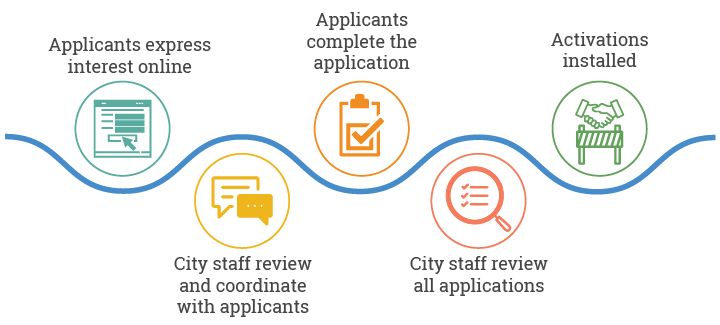
More information about specific program processes and rules will be available when you start your application.
Completed Healthy and Play Street applications that are not selected will remain eligible and will be considered in subsequent rounds for up to one year.
- FAQ
-
How was Living Streets initiated?
The Living Streets Program, outlined in Resolution No. 20211021-027, was adopted by Austin City Council on October 21, 2021.
How will getting to my home or business work? Can I have guests and take deliveries?
All local traffic for residents, including guests and deliveries will be maintained.
How will emergency vehicles get to my home or business?
Emergency access will be maintained at all times. Emergency responders have been made aware of the equipment.
How will my trash and recycling be collected and my mail and packages delivered?
All normal street services such as trash, recycling, mail and deliveries will be maintained.
Am I allowed to relocate the equipment if it’s in front of my house?
No, unfortunately the location of the equipment is important to the safety of the Living Streets activation. The location of equipment has been approved by licensed engineers at the City, and is not to be moved from its place on the street.
Can I have a bounce house at my NBP?Bounce houses and similar inflatable structures should be on private property and should not block any part of the street or sidewalks.
Can I put up tents at my NBP?You can have temporary (non-air inflated) tents in the closure if the following conditions are met:
- You maintain the emergency/local access lane (see Step 5 above)
- Each tent does not exceed 10'x10'
- The total square footage of all tents does not exceed:
- 700 sq ft – If all tents do not have sidewalls
- 400 sq ft – If any tent has sidewalls
Can I have music at my NBP?Yes! Amplified sound is allowed between 10:00 a.m. and 10:00 p.m and is limited to 75 decibels.
How were these streets selected?
Healthy Streets, Play Streets, and Neighborhood Block Parties have three main goals:
- Provide a place for people of all ages to play and recreate in the public right of way.
- Create stronger community ties between neighbors, foster residents’ sense of place within their neighborhood, and bring social interaction to the public right of way.
- Help provide safe, non-car-focused mobility connections to important destinations so that people feel more comfortable walking, biking, and rolling to where they need to go.
To achieve these goals, residents can apply for the program and city staff will review the applications for their potential to provide social and recreational space within the public right of way. Living Streets activations work best on low volume, low speed, residential streets. These considerations, along with an equity analysis and the percentage of resident support for the activation, determine which streets are selected.
How will Living Streets activations be monitored and maintained?
Austin Transportation and Public Works will monitor the activations. Resident Living Streets Ambassadors will also assist with observations and maintenance. If you are interested in becoming a Living Street Ambassador or would like to report an issue, please email us at LivingStreets@AustinTexas.gov.
How long will a Living Street activation be in place?
The duration of a Living Street activation depends on the type of activation. Neighborhood block parties are one-time events that last 24 hours or less. Play Streets and Healthy Streets both last 3-6 months depending on the application. Play Streets are set up and taken down at predetermined times during the week but for no more than 3 days a week and no more than 12 hours a week in total. Healthy Streets are always set up, 24 hours a day, for the duration of the activation.
Can I still park on the street?
Yes, you may park on the street in areas where on-street parking is permitted.
How can I remove a Living Streets activation?
Any resident can request that a Living Streets activation be removed. The resident must get 60% of the affected parcels along the Living Street activation to sign that they want the activation removed. These parcels will be the same parcels that the applicant had to get 60% signatures from to install the activation. If you would like to remove a Living Streets activation, please email LivingStreets@austintexas.gov and staff will provide you with additional details.
How can I get involved and help with Living Streets?
There are a variety of ways you can get involved to help make the Living Streets Program successful.
- Call 3-1-1 to report damaged or missing traffic control devices, such as cones, barricades or signage.
- Sign up to be a Living Streets Ambassador: Street Ambassadors will be Austin Transportation and Public Works’ eyes and ears on the street who help monitor barricade placement, report issues and help keep neighbors and the City informed. Email LivingStreets@AustinTexas.gov to let us know you’re interested.
- Give us your feedback on Living Streets by emailing LivingStreets@AustinTexas.gov
- Spread the word! Tell your friends and neighbors about Living Streets. On social media, use the hashtag #LivingStreetsATX to share how you’re using Living Streets.


